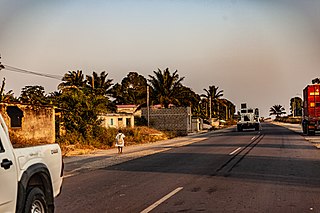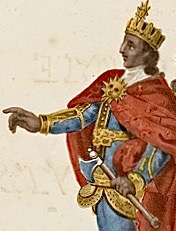
Álvaro I Nimi a Lukeni lua Mvemba was a Manikongo, or king of Kongo, from 1568 to 1587 and the founder of the Kwilu dynasty.

The Kingdom of Kongo was a kingdom located in central Africa in present-day northern Angola, the western portion of the Democratic Republic of the Congo, the Republic of the Congo as well as the southernmost part of Gabon. At its greatest extent it reached from the Atlantic Ocean in the west to the Kwango River in the east, and from the Congo River in the north to the Kwanza River in the south. The kingdom consisted of several core provinces ruled by the Manikongo, the Portuguese version of the Kongo title Mwene Kongo, meaning "lord or ruler of the Kongo kingdom", but its sphere of influence extended to neighbouring kingdoms, such as Ngoyo, Kakongo, Loango, Ndongo and Matamba, the latter two located in what is Angola today.

Kwilu, also known as the House of Kwilu, was a kanda or royal lineage of the Kingdom of Kongo.

Soyo is a city, with a population of 200,920, and a municipality, with a population of 227,175, located in the province of Zaire in Angola, at the mouth of the Congo river. Soyo recently became the largest oil-producing region in the country, with an estimate of 1,200,000 barrels per day (190,000 m3/d).

The Kinlaza were members of the Nlaza kanda or House of Kinlaza, one of the ruling houses of the Kingdom of Kongo during the 17th century. It was one of the main factions during the Kongo Civil War along with the Kimpanzu and Kinkanga a Mvika kandas. They are remembered in tradition and are evoked in a proverb, still current in the 1920s Nkutama a mvila za makanda "Kinkanga, Kimpanzu ye Kinlaza makukwa matatu malambila Kongo".
Mvemba a Nzinga, Nzinga Mbemba or Funsu Nzinga Mvemba, also known as King Afonso I, was the sixth ruler of the Kingdom of Kongo from the Lukeni kanda dynasty and ruled in the first half of the 16th century. He reigned over the Kongo Empire from 1509 to late 1542 or 1543.
Lukeni lua Nimi was the traditional founder of the Lukeni kanda dynasty, first king of Kongo and founder of the Kingdom of Kongo Dia Ntotila. The name Nimi a Lukeni appeared in later oral traditions and some modern historians, notably Jean Cuvelier, popularized it. He conquered the kingdom of Mwene.
Pedro II Nkanga a Mvika was a ruler of the kingdom of Kongo during the kingdom's first conflict with the Portuguese colony of Angola. He was the founder of the royal House of Nsundi and could trace his descent to one of Afonso I's daughters.
The precolonial history of Angola lasted until Portugal annexed the territory as a colony in 1655.
Nkuwu a Ntinu was the fourth manikongo from the Lukeni kanda dynasty to rule the Kingdom of Kongo and reigned during the mid 15th century between c. 1450 and c. 1470.
Nlaza of Kongo was a manikongo from the Lukeni kanda dynasty and the 3rd ruler of the Central African kingdom of Kongo in the early 15th century between c. 1435 and c. 1450. Little is known about him or his reign other than he was one of two cousins of Kongo's founder, Lukeni lua Nimi.
Bernardo I of Kongo was a 16th-century manikongo (ruler) of the Kingdom of Kongo, a region encompassing areas in 21st-century Angola and the Democratic Republic of Congo. He came to power after murdering his half-brother Afonso II who was less well-disposed toward the Portuguese.

Henrique I Nerika a Mpudi was ruler of the Kingdom of Kongo from 1567 to 1568 and the last from the Lukeni kanda dynasty. Like his predecessor Bernardo I, Henrique died while on campaign at the frontiers of the kingdom. He was killed while fighting the BaTeke of the Anziku Kingdom.

Álvaro VI of Kongo, sometimes called Nimi a Lukeni a Nzenze a Ntumba, was a ruler of the Kingdom of Kongo.

The Kilukeni were members of the Lukeni kanda or House of Kilukeni, the ruling dynasty of the Kingdom of Kongo from its inception in the late 14th century until the 1567 with the rise of the House of Kwilu. The Kilukeni were springboard for most of the major factions that battled for control of Kongo during its civil war.
Manuel III Afonso of Kongo, previously Manuel Martins Kiditu, was the last Mwenekongo (ruler) of the Kingdom of Kongo, ruling as a vassal of the Portuguese empire from 1911 to 1914.
José I Mpasi a Nkanga, or Zuzi, was ruler of the Kingdom of Kongo between 1779 and 1785. He was the first ruler from the branch of the House of Kinlaza that came from the southeast of the country, known as the Nkondo ranch, and the first to be included in the kinglists produced by Jean Cuvelier. When José ascended to the throne, the Mbamba Lovata branch of the Kimpanzu house under Pedro V once again contested the throne, which led to a conflict between the two houses once again. This culminated in a decisive battle outside of the capital, São Salvador which was a victory for José, and confirmed his rule. On his death, he was succeeded by his brother Afonso V.
Henrique III Mpanzu a Nsindi a Nimi a Lukeni was ruler of the Kingdom of Kongo from the Kivuzi branch of the Kinlaza house, who reigned from 1840 until 1857. Henrique came to power when he overthrew his predecessor, André II. This was with the support of the elector Ntinu Nsaku. Henrique did not manage to kill Andre II and King Andre continued to exercise power from Mbanza Maputu over some of the Kongo realm.





